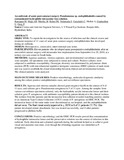| dc.description.abstract | OBJECTIVE:
To report the investigation for the source of infection and the clinical course and treatment response of 11 cases of acute post-cataract surgery endophthalmitis that developed during an outbreak.
DESIGN:
Retrospective, consecutive, interventional case series.
PARTICIPANTS:
Eleven patients who developed acute postoperative endophthalmitis after an uneventful cataract surgery with intraocular lens implantation from September 6 to 29, 2010, at a tertiary eye care center in South India.
METHODS:
Aqueous aspirates, vitreous aspirates, and environmental surveillance specimens were sampled. All specimens were subjected to smear and culture. Positive cultures were subjected to antibiotic susceptibility. Genotypic diversity was determined by polymerase chain reaction (PCR) with enterobacterial repetitive intergenic consensus (ERIC) primers of each strain and was used to establish the clonal relationship between clinical and environmental isolates. The clinical patterns were analyzed.
MAIN OUTCOME MEASURES:
Positive microbiology, molecular diagnostic similarity among the culture positive endophthalmitis cases, and surveillance specimens.
RESULTS:
Aqueous and vitreous samples showed gram-negative bacilli in the smears of 8 of 11 eyes, and cultures grew Pseudomonas aeruginosa in 5 of 11 eyes. Among the samples from various surveillance specimens cultured, only the hydrophilic acrylic intraocular lenses and their solution grew P. aeruginosa, with antibiotic susceptibility pattern identical to the clinical isolates. The isolates from the patients and the intraocular lens solution revealed matching patterns similar to an American Type Culture Collection (ATCC) strain of P. aeruginosa on ERIC-PCR. The intraocular lenses of the same make were discontinued at our hospital, and the endophthalmitis did not recur. The final visual acuity improved to ≥ 20/50 in 8 of 11 patients (72.7%). One patient developed retinal detachment, but was treated successfully, and 2 other patients progressed to phthisis bulbi.
CONCLUSIONS:
Positive microbiology and the ERIC-PCR results proved that contamination of hydrophilic intraocular lenses and the preservative solution was the source of infection in this outbreak. Early detection and a planned approach during the outbreak helped us to achieve good visual and anatomic outcomes, even though the offending organism was identified as P. aeruginosa. | en |

